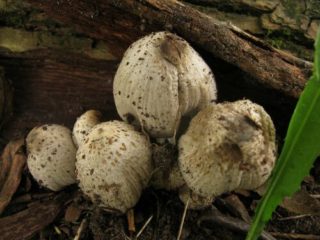Content
Woodpecker newt is an inedible, hallucinogenic mushroom of the Psatyrellaceae family. Grows among deciduous trees on fertile soil. It begins to bear fruit from the beginning of August and lasts until the first frost. Since the species is not eaten, you need to know a detailed description, view photos and videos.
Where does the woodpecker grow?
Woodpecker dung beetles can be found on rotten wood. Prefers to grow on nutritious soil, both on the plain and on the hills. The woodpecker dung beetle begins to bear fruit from the end of summer; you can see the mushroom in the forest until the first days of November.
What does a woodpecker look like?
The cap reaches 10 cm and at a young age has the shape of a cylinder or cone, then takes on the appearance of a bell. The edges of older specimens rise upward, exposing the lamellar layer.
A young woodpecker dung beetle completely hides a snow-white velvety blanket; as it grows, it collapses, leaving large whitish flakes. The surface is covered with smooth white skin with pronounced dark stripes. The pulp is tender, thin, white or pale pink.
The spore layer is formed by convex, non-merging plates. In young specimens they are whitish, becoming gray-yellow and dark brown with age. Woodpecker dung beetles reproduce by elongated spores that are embedded in a dark brown or black powder.
The dense stem is tall, reaches a height of 15 cm. The shape is cylindrical, thinning at the top and thickening towards the base. The surface is covered with whitish skin with sparse flocculent scales. There is no ring on the leg. The flesh of the woodpecker dung beetle does not change color when mechanically damaged.
Is it possible to eat woodpecker dung beetle?
This representative of the forest kingdom is considered hallucinogenic. The pulp exudes a characteristic tarry odor and has no taste. When consuming this type, food poisoning, mental confusion, and even loss of consciousness can occur.
But if a woodpecker dung beetle somehow gets onto the table, you need to be able to distinguish the symptoms of poisoning and provide first aid.
Similar species
The woodpecker dung beetle coprinus picaceus has a beautiful appearance, so it is very difficult to confuse it with other species.But inexperienced mushroom pickers manage to confuse it with such representatives as:
- Gray or inky dung beetle - an inedible fellow with a cylindrical cap of ash-gray color and a long, hollow stem. It grows in deciduous forests and begins to bear fruit in late summer. When consumed, it causes gastric upset.
- Shaggy dung beetle - an edible representative of the forest kingdom. But, in order not to harm your body, only young fruiting bodies are collected while their plates are painted whitish. The mushroom can be recognized by its oblong shape, painted white with large scales. With age they become dark gray or black. They grow in large families within the city and in basements. They prefer fertile, nitrogenous soil. They bear fruit from spring until the first frost.
- Snow white dung beetle - an inedible representative with an ovoid cap covered with a white powdery coating. The whitish leg is long, swollen, rough. Since the appearance is very attractive and there is no unpleasant odor, many people mistake it for an edible specimen. If signs of intoxication appear when consuming this species, it is better to consult a doctor.
Symptoms of poisoning and first aid
The woodpecker dung beetle is an inedible, hallucinogenic species. When consumed, it causes gastric upset and clouding of consciousness. When picking mushrooms, it is better to pass by unknown specimens, but if this species accidentally ends up in the basket and then on the table, then you need to know the signs of poisoning. Symptoms depend on the amount of mushrooms eaten and are divided into mild, moderate and severe stages.
Light degree:
- nausea, vomiting;
- pain in the epigastric region;
- diarrhea up to 20 times a day.
The first symptoms appear 1-2 hours after eating. As dehydration progresses, the condition worsens, even to the point of fainting.
Average degree:
- temperature increase;
- cold, clammy sweat;
- yellowness of the skin;
- liver enlargement.
These symptoms appear after a few days if first aid was not provided or if the woodpecker dung beetle was consumed with alcohol.
Heavy:
- agitation or lethargy;
- hallucinations;
- lowering blood pressure;
- cardiopalmus;
- muscle pain;
- convulsions;
- transition to an unconscious state, even death.
If signs of poisoning appear, it is necessary to provide prompt medical assistance. Before the ambulance arrives, you must:
- rinse the stomach;
- give activated carbon (1 tablet per 10 kg of body weight);
- if there is no diarrhea, give laxatives;
- to improve blood circulation, apply heat to the legs and stomach;
- open the windows and free the victim from constricting clothing for better access to fresh air;
- Give the patient as much water as possible.
Conclusion
The woodpecker dung beetle is an inedible, hallucinogenic member of the fungal kingdom. Grows among deciduous trees, on soil enriched with humus. It begins to bear fruit at the end of summer. When picking mushrooms, you must remember that inedible mushrooms cause food poisoning, so if you see an unfamiliar specimen, it is better to pass by.














